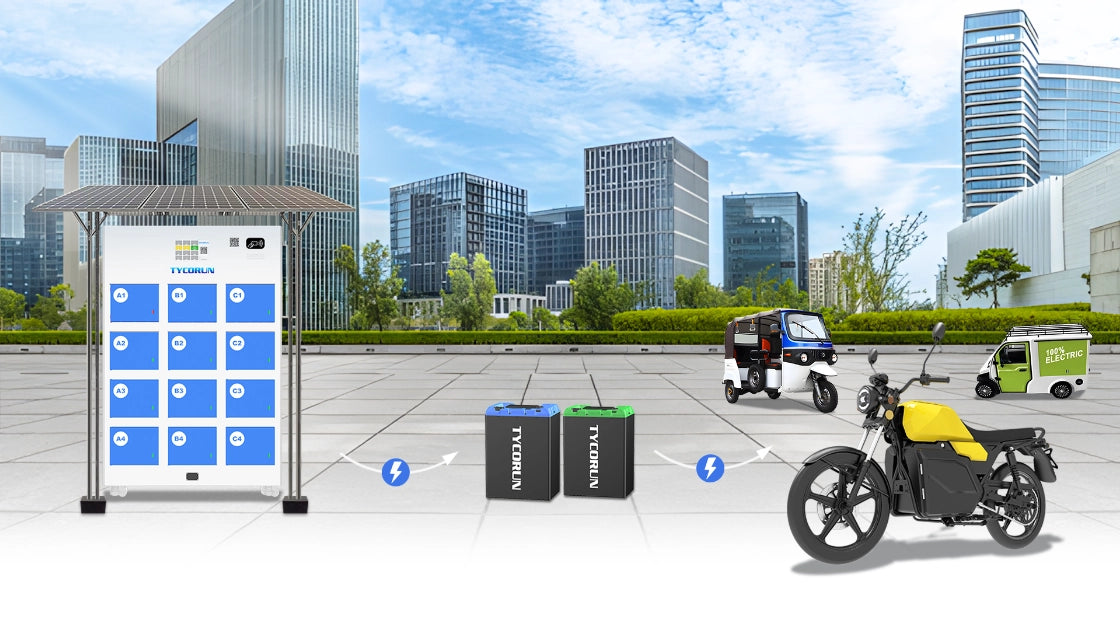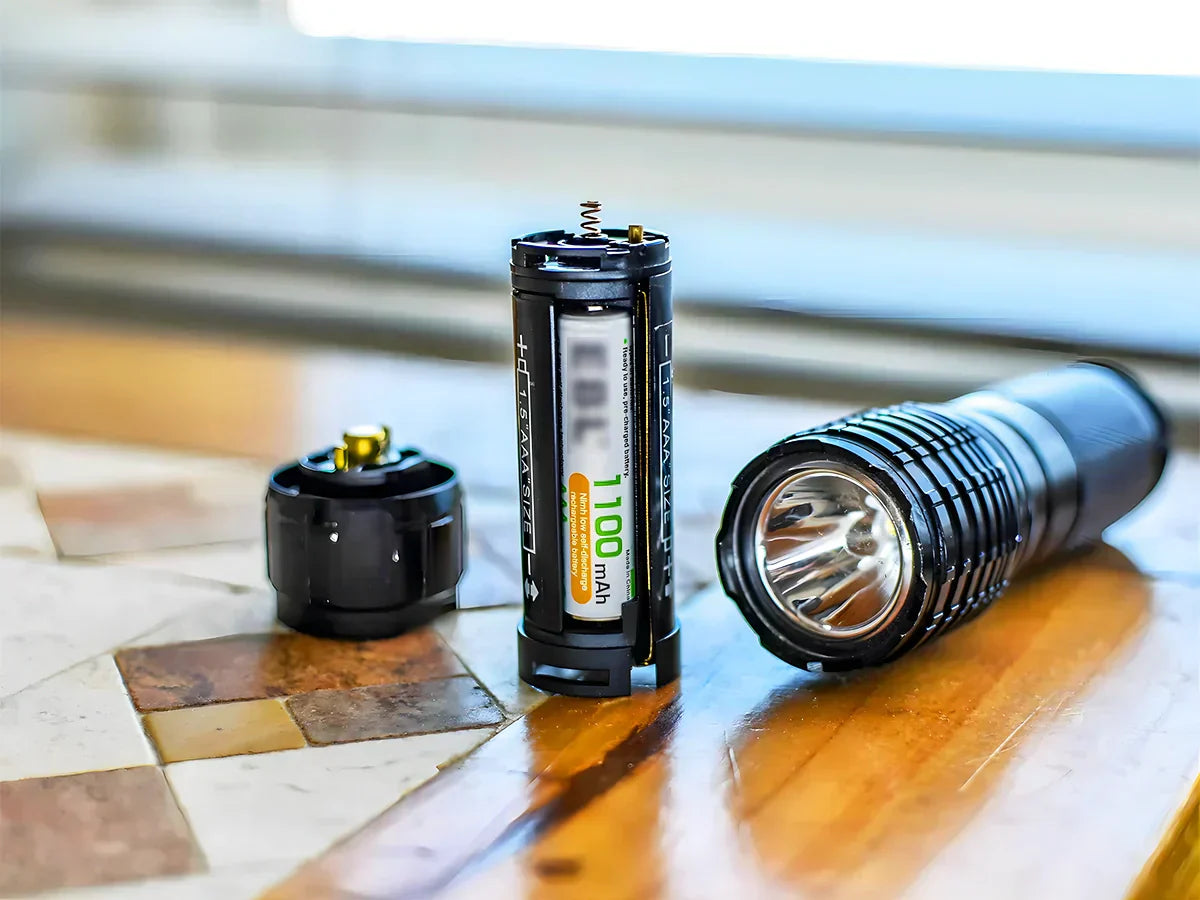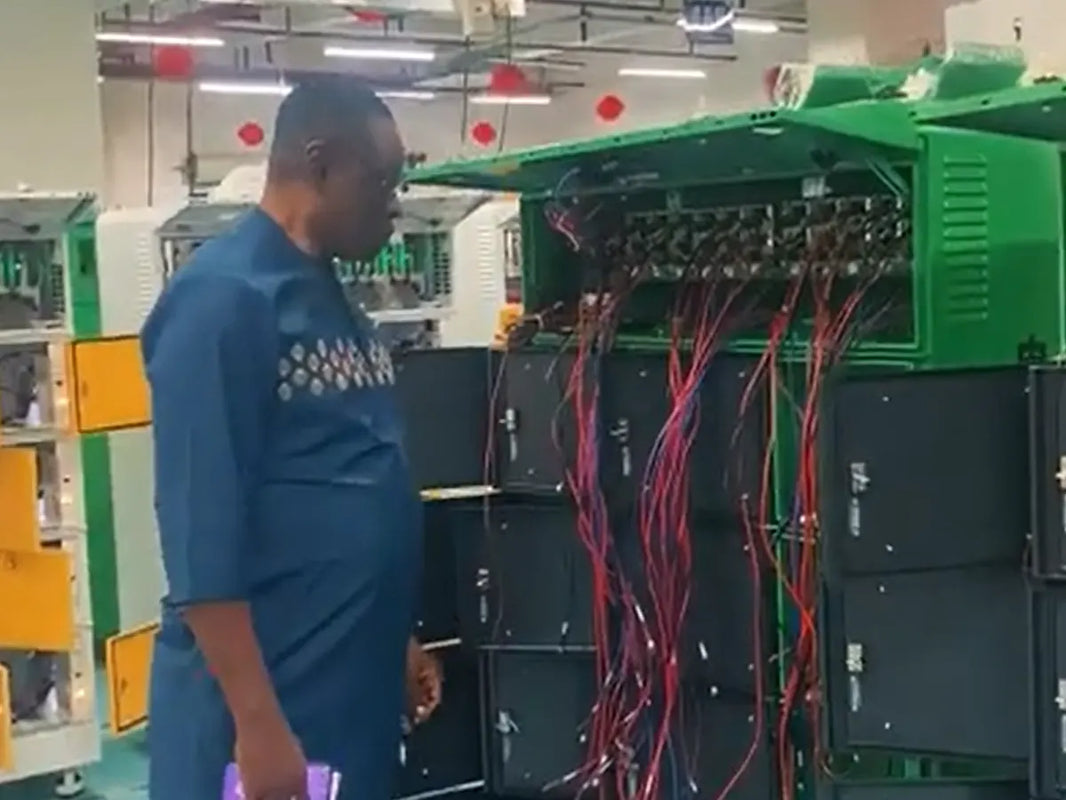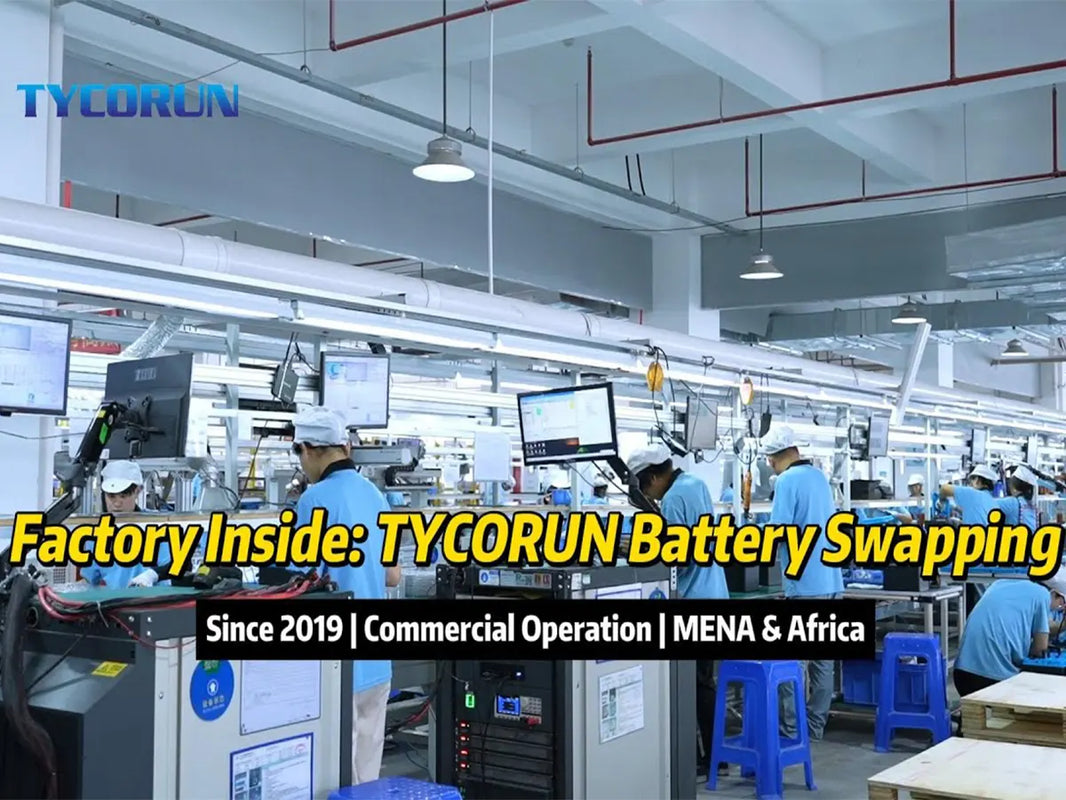
Main content:
- The Importance of Batteries in Flashlight Performance
- Common Flashlight Battery Types
- Choosing Flashlight Type and Application Based on Flashlight Battery Size
- Common Battery Sizes Chart for Flashlights
- How to Choose the Right Flashlight Battery
- Flashlight Battery Charging and Safety Precautions
- Conclusion
- FAQs
Flashlight batteries are the core of every reliable light source, determining brightness, runtime, and safety. Whether you’re using a compact EDC flashlight or a tactical torch, choosing the right battery type—alkaline, NiMH, or lithium-ion—ensures consistent performance and durability in any situation. Understanding flashlight batteries helps users make smarter, safer power choices.
The Importance of Batteries in Flashlight Performance

The battery is the "heart" of a flashlight, directly determining its brightness, runtime, and overall performance. Different battery types have different output characteristics and energy density. High-performance batteries allow a flashlight to maintain stable brightness for longer and operate reliably even in low temperatures or under heavy loads. Conversely, using batteries with insufficient capacity or unstable battery voltage will not only reduce brightness but may also cause flickering, overheating, and other issues, impacting the user experience.
Choosing the right battery is crucial not only for performance but also for safety. Especially for high-brightness or tactical-grade flashlights, batteries must maintain stable output during high-current discharge to avoid damage or even safety hazards caused by overdischarge or overcharging. Understanding the characteristics and application scenarios of different batteries will help users achieve the optimal balance between performance and safety, maximizing the effectiveness of their flashlight.
Common Flashlight Battery Types

Alkaline Batteries
Advantages: Easy to purchase, low cost
Disadvantages: Non-rechargeable, prone to leakage, limited capacity
Alkaline batteries are readily available at nearly any supermarket or convenience store and are the preferred choice for many home flashlights.
They use a zinc-manganese chemistry and typically have a voltage of 1.5V, meeting the basic lighting needs of low-power devices. However, because alkaline batteries are non-rechargeable, they are more expensive to use over time. Furthermore, their battery performance degrades significantly under high-current discharge conditions, making them prone to leakage and corrosion of the flashlight's electrodes. If your flashlight is only for emergency backup or occasional use, alkaline batteries are still a convenient choice.
Check Lithium aa Batteries vs Alkaline for more information
Nickel-Metal Hydride (NiMH) Batteries
Advantages: Rechargeable, stable output, environmentally friendly
Disadvantages: Moderate energy density, high self-discharge rate
NiMH batteries are an ideal upgrade for alkaline batteries. They use a nickel-metal hydride chemistry with a nominal voltage of 1.2V and are compatible with standard AA or AAA battery slots.
NiMH batteries can be recharged hundreds of times and have a stable discharge voltage, providing more stable light output. They are particularly suitable for flashlights used frequently at home or at work.
In addition, NiMH batteries do not contain toxic heavy metals, making them more environmentally friendly.
It is important to note that their energy density is slightly lower than that of lithium-ion batteries, and they lose charge over time if not used. Therefore, regular maintenance with a smart charger is recommended.
Lithium Primary Batteries
Advantages: Long life, low-temperature resistance, high capacity
Disadvantages: High price, non-rechargeable
Lithium primary batteries (such as CR123A or Energizer Ultimate Lithium) are widely used in high-performance flashlights due to their excellent energy storage properties. These batteries typically have a nominal voltage of 3.0V, which is higher than standard alkaline or NiMH batteries, resulting in higher light output.
They are particularly suitable for use in extreme environments, such as high mountains, cold regions, and wilderness exploration, as they maintain a stable voltage even at low temperatures. However, as disposable batteries, they are more expensive and cannot be recharged or recycled after use.
Thus, these batteries are more suitable for emergency equipment, tactical flashlights, or applications where frequent battery replacement is inconvenient.
Lithium-ion Rechargeable Batteries (Li-ion)
Typical Models: 18650, 21700, 14500, 26650
Advantages: High energy density, long cycle life, and high output current
Disadvantages: Requires a dedicated charger and poses risks of overcharging and over-discharging
Li-ion batteries are the mainstream choice for modern high-performance flashlights.
They offer significantly higher energy density than NiMH or alkaline batteries, with a single-cell voltage of 3.6-3.7V, stable discharge, and powerful output.
For a given size, Li-ion batteries provide flashlights with longer battery life and higher brightness.
The 18650 is currently the most commonly used model, while the 21700 is becoming a trend due to its larger capacity and greater discharge capability.
The cycle life of Li-ion batteries is typically between 500 and 1000 cycles. Using a battery management system (BMS) or smart charger significantly improves safety and battery life. It's important to note that these batteries must be used with a compatible charging device to avoid overcharging, short-circuiting, or high-temperature exposure to ensure safe use.
Selecting Flashlight Specifications and Applications by Battery Type
Common flashlight batteries include button cells, AAA (10440), AA (14500), CR123A (16340), 18650 (equivalent to 2 x CR123A), 26650, C cells, and D cells.
Flashlights use batteries ranging from one to multiple cells. Multi-cell flashlights typically increase their size to improve brightness and battery life.
Choosing Flashlight Type and Application Based on Flashlight Battery Size
AAA flashlights: Extremely compact, suitable for everyday carry (EDC) use, often found in keychain flashlights. Their brightness typically does not exceed 100 lumens, making them suitable for everyday lighting. Some models are compatible with 10440 rechargeable lithium batteries, but the battery life is shorter.
AA flashlights: Offer a balance between size and brightness. A single battery is suitable for home use or portable use, while two or more batteries can increase brightness and battery life. Some models can use 14500 lithium batteries.
CR123A/16340 flashlights: These are commonly used in professional equipment and tactical flashlights, offering high energy density and low-temperature resistance. A single battery provides high brightness and long battery life; a two-battery configuration is the standard tactical configuration.
Note that while the 16340 and CR123A are similar in size, some flashlights are not fully compatible, so caution should be exercised when replacing them.
18650 flashlights: Currently the most popular high-performance flashlight battery, they offer high energy density and high discharge current, making them suitable for outdoor, search, or emergency use. One 18650 battery is sufficient for high brightness; two or more batteries are typically used for higher power or multi-LED designs.
26650 flashlights: These are larger and offer higher capacity, making them suitable for long-range flashlights, industrial lighting, or long-range applications.
Common Battery Sizes Chart for Flashlights
| Battery Model | Dimensions (mm) | Voltage (V) | Common Uses |
|---|---|---|---|
| AA / AAA | 50 × 14 / 44 × 10 | 1.2–1.5 | Everyday small flashlights |
| 14500 | 50 × 14 | 3.7 | High-power portable flashlights |
| 16340 / CR123A | 34 × 16 | 3.0–3.7 | Tactical flashlights |
| 18650 | 65 × 18 | 3.6–3.7 | Mid-to-high-end flashlights |
| 21700 | 70 × 21 | 3.6–3.7 | High-power, long-run flashlights |
| 26650 | 65 × 26 | 3.6–3.7 | Industrial / outdoor flashlights |
How to Choose the Right Flashlight Battery

Based on Voltage Requirements
Verify the flashlight's supported voltage range. Using batteries with a voltage that's too high (for example, replacing a CR123A with a 16340) can damage the circuitry. Using batteries with a voltage that's too low can result in insufficient brightness or even failure to light.
Based on Battery Life Requirements
The larger the capacity (mAh), the longer the flashlight can run. Higher-capacity batteries store more energy, providing extended runtime for outdoor use or emergencies. Choosing the right capacity ensures reliable performance without frequent recharging or replacement.
Based on Usage
Outdoor Exploration
18650 or 21700 lithium-ion batteries are recommended. 18650 lithium-ion batteries are currently the dominant type of high-intensity flashlight. Typically ranging in capacity from 2500mAh to 3500mAh, these batteries offer strong discharge capacity (supporting high-brightness mode), a high voltage platform (3.7V), and rechargeability. They strike an ideal balance between practicality, performance, and cost, making them the preferred and recommended option for most users.
21700 lithium-ion batteries are larger and longer than 18650 batteries, with capacities increased to 4000mAh to 5000mAh and improved discharge performance, making them ideal for users seeking extreme battery life or long-term high-brightness output. While larger and heavier, they offer significant performance advantages. 26650 lithium-ion batteries are commonly used in large flashlights or long-range telescopes. However, their larger size and weight make them less portable, and they are gradually being replaced by 21700 batteries.
Home Backup
The biggest advantage of AA/AAA (nickel-metal hydride/alkaline) batteries is their ease of availability, making them easy to find even in remote areas. However, their lower voltage (1.2V/1.5V), limited capacity, and weak discharge capacity make them less suitable for high-brightness flashlights. This type of flashlight is more suitable for low-brightness everyday use (EDC) or as an emergency backup, and is not recommended as a primary power source.
Freezing Environments
Primary lithium batteries (such as the CR123A) perform exceptionally well in low temperatures, maintaining stable discharge even at -20°C. They are lightweight and durable, making them suitable for use in extremely cold regions, mountaineering, outdoor activities in northern China, or as long-term backup flashlights.
Rechargeable RCR123A (16340) batteries, while powerful, have a higher voltage. Before use, ensure the flashlight supports this type of flashlight to avoid damaging the circuit.
Compatibility Check
Length: Batteries from different brands may vary slightly in length, which may result in a problem with the flashlight or poor contact.
Polarity: Ensure the positive and negative terminals are correctly oriented when inserted.
Charging Specifications: If the flashlight supports Type-C direct charging, a charger, or external charging only, avoid mixing incompatible devices.
Protective Board Design: Lithium batteries with a protective board are safer, preventing overcharging, over-discharging, and short circuits.
Brand Selection Recommendations
EBL: A cost-effective rechargeable battery brand suitable for home use and EDCs.
Eneloop: Long cycle life and stable performance.
Samsung / LG / Molicell: Widely used in high-performance flashlights and electric vehicle batteries, safe and reliable.
Panasonic: High energy density and excellent stability, a common choice for high-end flashlights.
Avoid unbranded or underpriced batteries, as they may have inflated capacity, overheating, or leakage risks.
Flashlight Battery Charging and Safety Precautions

Safety is always paramount when charging flashlight batteries or using them daily. Prefer to use the original flashlight charger. If a replacement is necessary, ensure the charger's voltage and current specifications match the flashlight battery. Avoid using inferior or incompatible chargers to prevent damage to the battery or safety issues.
Avoid overcharging, over-discharging, and short-circuiting during charging. Continuing to charge a lithium battery for an extended period after it is fully charged can damage the cell and even pose a safety hazard. Over-discharging, on the other hand, can cause capacity degradation and shorten the cycle life. Regularly checking your flashlight for low-voltage protection can effectively prevent over-discharge.
Also, avoid mixing different types of batteries. For example, rechargeable lithium batteries should not be used with disposable alkaline or nickel-metal hydride batteries. Doing so can easily lead to voltage imbalance, leakage, or explosion.
If batteries need to be stored for an extended period, it is recommended to keep the battery approximately 50% charged. When charging, keep the flashlight in a dry, well-ventilated area away from flammable materials. Avoid charging in hot, humid environments, or direct sunlight.
Avoid direct sunlight, hot, and humid environments to extend the lifespan. Avoid using the flashlight while charging to avoid straining the battery. Remove the flashlight regularly and inspect it for signs of bulging, leakage, or abnormal heating. If any problems are detected, discontinue use and dispose of them safely.
Conclusion
Selecting the right flashlight battery goes beyond simple power—it’s about reliability, efficiency, and safety. From daily use to outdoor adventures, matching the correct battery type with your flashlight ensures steady brightness and long-lasting performance. Smart battery choices mean brighter light, longer life, and safer illumination.
FAQs
What kind of batteries does a flashlight take?
Flashlights can use a variety of battery types, including common alkaline, nickel-metal hydride, lithium primary, and lithium-ion rechargeable batteries. AA or AAA sizes are often used for everyday household flashlights, while outdoor, high-intensity, or professional flashlights often use lithium-ion batteries such as 18650 and 21700 for longer battery life and higher brightness.
What brand of AA battery lasts the longest?
Among AA batteries, Energizer Ultimate Lithium performs best, offering high capacity, low-temperature resistance, and a long storage life. Its battery life significantly outperforms alkaline or NiMH rechargeable batteries. For long-term economical and environmentally friendly options, Panasonic Eneloop rechargeable batteries offer a high cycle life and stable performance.
What causes AA batteries to drain quickly?
Rapid drain of AA batteries is usually related to the power of the device, discharge current, and battery type. Alkaline batteries experience a rapid voltage drop under high current, resulting in insufficient battery life. Batteries stored for extended periods may also lose capacity due to self-discharge. For frequent flashlight use, NiMH or lithium batteries should be selected for increased durability.
Which flashlight battery has the longest lifespan?
Of all battery types, lithium primary batteries have the longest shelf life, reaching over 10 years, making them suitable for long-term backup. Lithium-ion batteries, on the other hand, offer a longer cycle life, capable of 500-1000 charge and discharge cycles, making them ideal for frequent users. Choosing the right flashlight battery for your application can balance lifespan and performance.















